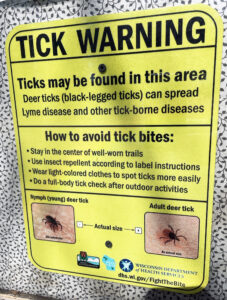By Michael Hillstrom, DNR Forest Health Specialist
Michael.Hillstrom@wisconsin.gov
Ticks are active now, so it’s time to start taking precautions to prevent tick bites and transmission of the diseases they carry. Whenever temperatures at ground level get above 40-42 degrees Fahrenheit, ticks will start to be active.

A tick warning sign is posted at many Wisconsin State Parks. / Photo Credit: Wisconsin DNR
Lyme disease, transmitted by black-legged ticks (also known as deer ticks), is the most well-known health concern related to ticks in Wisconsin. However, anaplasmosis, babesiosis and other diseases are also spread by these ticks.
American dog ticks (also known as wood ticks) and the lone star tick, a relatively new arrival to the state, do not often cause disease issues in Wisconsin but can in other parts of the United States.
Wearing long pants and using repellents or permethrin-treated clothing are good practices to prevent tick bites, but it’s still important to perform tick checks as soon as possible after every visit to areas where ticks may have been present. If you find an attached tick, remove it as soon as possible and monitor for disease symptoms for 30 days.
You can use resources such as the Wisconsin tick and tick-borne diseases webpage to identify ticks and learn about the diseases they cause; submit a photo to the Wisconsin Department of Health Services (DHS) for tick identification; or even have a tick tested for diseases at a private lab.
If you’d like to contribute to tick research, consider downloading The Tick App.
For information about tick and mosquito safety, visit the Wisconsin Department of Health Services website and watch for their 2025 Fight the Bite campaign.
